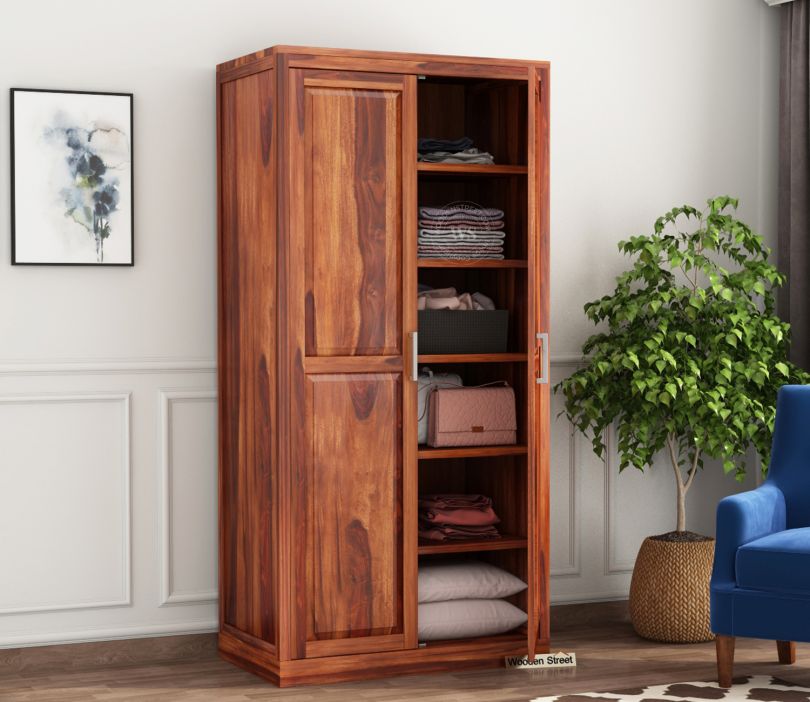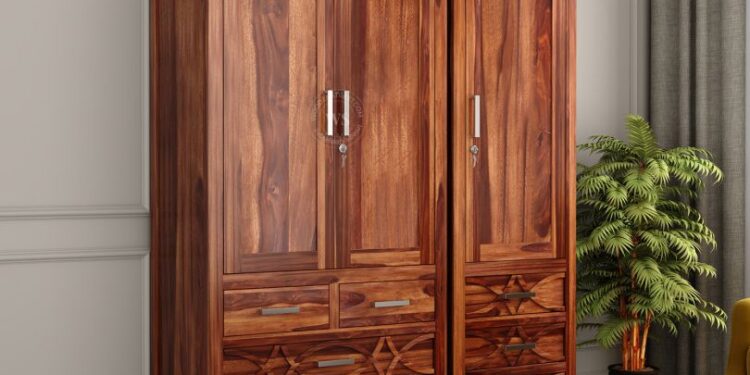When it comes to selecting the ideal wardrobe for your bedroom, the material plays a pivotal role in determining its durability, aesthetics, and functionality. With a plethora of options available, it’s essential to understand the characteristics of each material to make an informed decision. This article delves into the three most popular wardrobe materials: wood, laminate, and metal, highlighting their pros, cons, and suitability for various needs.
1. Wooden Wardrobes: Timeless Elegance
Overview: Wooden wardrobes have been a staple in bedroom furniture for centuries, offering a blend of natural beauty and robust construction.
Pros:
- Aesthetic Appeal: Wood exudes warmth and sophistication, enhancing the overall ambiance of the bedroom.
- Durability: High-quality wood, such as teak or oak, ensures longevity and can withstand wear and tear.
- Customizability: Wooden wardrobes can be easily customized in terms of size, design, and finish to match personal preferences.
Cons:
- Cost: Premium wooden wardrobe can be expensive due to the quality of materials and craftsmanship involved.
- Maintenance: Wood requires regular maintenance, including polishing and protection from moisture, to prevent damage.
- Susceptibility to Pests: Without proper treatment, wood can be prone to termite infestations.
Ideal For: Individuals seeking a classic, luxurious look with the flexibility of customization.
2. Laminate Wardrobes: Modern and Practical
Overview: Laminate wardrobes are engineered using composite materials covered with a decorative layer, offering a contemporary look at an affordable price.
Pros:
- Cost-Effective: Laminate wardrobes are budget-friendly, making them accessible for a broader audience.
- Variety of Designs: Available in numerous colors, textures, and finishes, allowing for versatile design options.
- Low Maintenance: Easy to clean and resistant to stains and scratches, reducing upkeep efforts.
Cons:
- Durability: While durable, laminate can be prone to chipping or peeling if not handled carefully.
- Environmental Impact: Some laminates may release formaldehyde and other chemicals, raising environmental concerns.
- Limited Repair Options: Damaged laminate surfaces are challenging to repair and may require replacement.
Ideal For: Budget-conscious individuals desiring a modern look with minimal maintenance.
3. Metal Wardrobes: Industrial Strength
Overview: Metal wardrobes are constructed from steel or aluminum, offering a sleek, modern appearance combined with robust functionality.
Pros:
- Durability: Metal wardrobes are resistant to dents, scratches, and other physical damages, ensuring longevity.
- Fire Resistance: Metal is non-combustible, providing added safety in case of fire.
- Pest Resistance: Unlike wood, metal is impervious to termites and other pests.

Cons:
- Aesthetic Limitations: Metal wardrobes may lack the warmth and charm of wooden options, potentially appearing cold or industrial.
- Prone to Rust: If not properly coated, metal can rust over time, especially in humid environments.
- Weight: Metal wardrobes can be heavy, making them challenging to move.
Ideal For: Individuals seeking a durable, secure, and low-maintenance wardrobe solution.
Comparison Table
| Feature | Wooden Wardrobe | Laminate Wardrobe | Metal Wardrobe |
|---|---|---|---|
| Aesthetic Appeal | High | Moderate | Low |
| Durability | High | Moderate | Very High |
| Maintenance | High | Low | Low |
| Customizability | High | Moderate | Low |
| Cost | High | Low | Moderate |
| Pest Resistance | Low | High | Very High |
Conclusion
Selecting the right wardrobe material hinges on individual preferences, budget constraints, and specific needs. Wooden wardrobes offer timeless elegance and customization but require diligent maintenance. Laminate wardrobes provide a modern aesthetic at an affordable price with minimal upkeep. Metal wardrobes stand out for their durability and security features, albeit with a more industrial look.
When choosing the perfect wardrobe for your bedroom, consider factors such as design harmony with existing furniture, climate conditions, and long-term maintenance capabilities. Each material has its unique advantages, and the best choice aligns with your personal style and practical requirements.
FAQs
Q1. Which material is best for a wardrobe – wood, laminate, or metal?
Each material has its advantages. Wooden wardrobes offer timeless appeal and strength, laminate wardrobes provide affordability and design flexibility, while metal wardrobes ensure maximum durability and low maintenance. Your choice depends on your budget, aesthetic preference, and usage needs.
Q2. Is a wooden wardrobe better than a laminate one?
A wooden wardrobe is more durable and elegant but requires regular maintenance, while a laminate wardrobe is easier to clean, affordable, and ideal for modern homes. For long-term investment and aesthetics, go for wood; for convenience and variety, choose laminate.
Q3. Are metal wardrobes still in trend for bedrooms?
Yes, metal wardrobes are regaining popularity, especially in minimalist and industrial-style interiors. They are sturdy, pest-resistant, and ideal for humid regions. Many modern designs also come with stylish finishes that blend well with bedroom décor.
Q4. How long does a wooden wardrobe last?
A wooden wardrobe made from high-quality wood like teak or oak can last 15–25 years or more with proper care. Regular polishing, cleaning, and termite treatment can extend its life significantly.
Q5. What are the disadvantages of laminate wardrobes?
The main drawbacks include less durability compared to wood, risk of chipping or peeling, and limited repair options. However, laminates are great for those seeking an affordable and trendy option.
Q6. Are laminate wardrobes waterproof?
Standard laminates are water-resistant but not entirely waterproof. You can opt for high-pressure laminates (HPL) or PVC-finished laminates for better moisture resistance, especially in humid climates.
Q7. Can I mix materials for my wardrobe design?
Absolutely. Many modern wardrobe designs combine wood and laminate or metal frames with wooden doors for a balanced look. Mixing materials enhances durability and adds a designer touch to your bedroom cupboard.
Q8. Which wardrobe material is easiest to maintain?
Laminate wardrobes are the easiest to maintain. They don’t require polishing or special treatments, and stains or dust can be easily wiped off with a damp cloth.
Q9. What’s the best wardrobe material for a humid climate?
For areas with high humidity, metal wardrobes or laminate wardrobes are better than wood, as they are resistant to moisture, warping, and termites.
Q10. Which wardrobe material adds the most value to home interiors?
Wooden wardrobes add premium value and timeless elegance to any bedroom. Their natural texture and rich finish make them ideal for enhancing interior aesthetics and long-term home value.
















